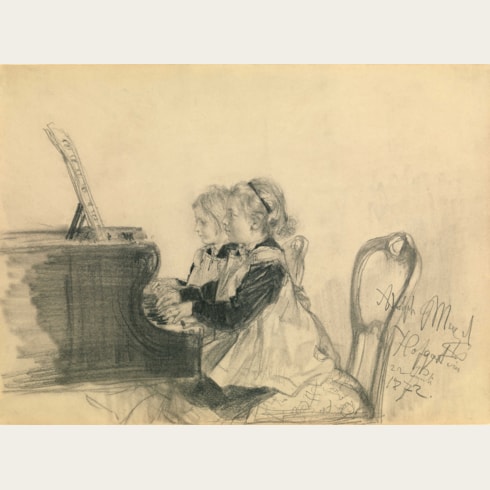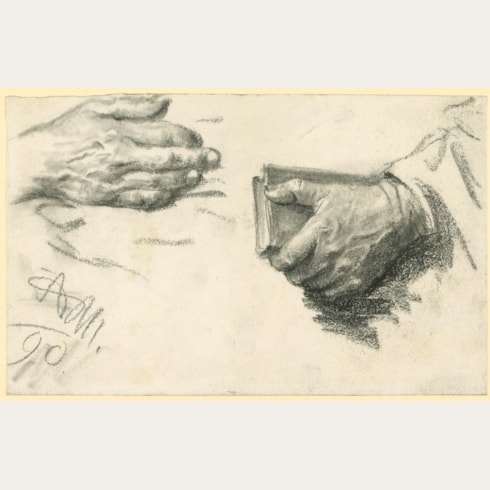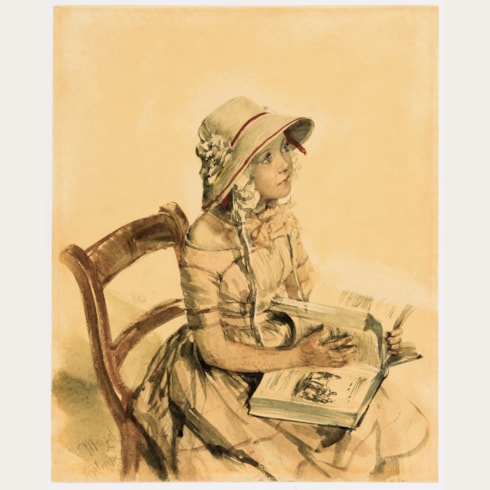Adolph MENZEL
(Breslau 1815 - Berlin 1905)
A Woman Wearing a Hat
191 x 134 mm. (7 1/2 x 5 1/4 in.) [sheet]
The first owner of this drawing was the artist’s nephew Otto Krigar-Menzel (1861-1929), who applied the Nachlass estate stamp - found on the verso of the sheet - onto those works which he retained in his possession after Menzel’s heirs had sold the bulk of the contents of his studio to the Nationalgalerie in Berlin in 1906, the year after painter’s death.
This drawing was then owned by the noted German-Jewish art dealer Walter Westfeld (1889-c.1943), who operated a gallery in Wuppertal-Eberfeld between 1920 and 1936, when he was forced to close his business by the Reich Chamber of Culture, which forbade Jews to deal in art. Westfeld was arrested in 1938 for supposed currency violations, and his collection was confiscated by the State and sold at auction in Cologne in December 19392. He was eventually sent to Theresienstadt and then to Auschwitz, where he died.
The present sheet was later acquired by the artist, art historian and museum curator Guido Josef Kern (1878-1953). Kern collaborated with Hugo von Tschudi on the first comprehensive catalogue and exhibition of Menzel’s work in 1905, and mounted an exhibition of fifty Menzel drawings at the Akademie in Berlin in 1921. As an artist, Kern was influenced by the work of Menzel and Max Liebermann.
Adolph Friedrich Erdmann von Menzel began his career working in his father’s lithography shop in Breslau (now Wroclaw in Poland) and later in Berlin, where his family moved in 1830. A brief period of study at the Akademie der Künste in Berlin in 1833 seems to have been the sum total of his formal training, and he is thought to have taught himself how to paint. At the outset of his career he worked as an illustrator, his activity in this field perhaps best exemplified by a series of some four hundred designs for wood engravings produced to accompany Franz Kugler’s History of Frederick the Great, published in instalments between 1840 and 1842. During the late 1840’s and 1850’s he was occupied mainly with a cycle of history paintings illustrating the life of Frederick the Great.
In 1861 Menzel received his most important official commission, a painting of The Coronation of King William I at Königsberg, on which he worked for four years. In the following decade, his lifelong interest in scenes of contemporary life culminated in what is arguably his masterpiece as a painter; the large canvas of The Iron Rolling Mill, painted between 1872 and 1875 and immediately purchased by the National-Galerie in Berlin. The last three decades of his career saw Menzel firmly established as one of the leading artists in Germany, a prominent figure in Prussian society and the recipient of numerous honours including, in 1898, elevation to the nobility. In the late 1880’s he began to abandon painting in oils in favour of gouaches, although old age meant that these in turn were given up around the turn of the century. Yet he never stopped drawing in pencil and chalk, able always to find expression for his keen powers of observation. A retrospective exhibition of Menzel’s work, held at the National-Galerie in Berlin a few weeks after the artist’s death in 1905, included more than 6,400 drawings and almost 300 watercolours, together with 129 paintings and 250 prints.
A passionate and supremely gifted draughtsman, Menzel was equally adept at watercolour, pastel, gouache and chalk. He was also able to draw with either hand, although he seems to have favoured his left. An immensely prolific artist (over four thousand drawings by him, together with 77 sketchbooks, are in the collection of the Nationalgalerie in Berlin alone), it is said that Menzel was never without a sketchbook or two in his pocket. His friend Paul Meyerheim described the artist’s appearance: ‘In his overcoat he had eight pockets, which were partially filled with sketchbooks, and he could not comprehend that there are artists who make the smallest outings without having a sketchbook in their pocket…an especially large pocket was installed…to hold a leather case, which held a pad, a coupe of shading stumps and a gum eraser.’ Menzel was widely admired as a draughtsman by his contemporaries, both in Germany and abroad, and Edgar Degas, for one, is known to have owned at least one drawing by him.
Provenance
By descent to the artist’s nephew, Otto Krigar-Menzel, Berlin, with the Adolph Menzel Nachlass stamp (Lugt 4602) on the verso
Possibly his daughter, Ingrid Brebeck
Walter Westfeld, Wuppertal-Eberfeld, until April 1937 or shortly thereafter
Possibly the office of the Generalstaatsanwaltschaft, Düsseldorf
Possibly their sale (‘Zwangsversteigerung…aus Nichtarischem Besitz’), Cologne, Kunsthaus Mathias Lempertz, 12-13 December 1939, part of lot 2071
Guido Joseph Kern, Berlin and Wasserburg am Inn
His wife, Franziska Kern, Berlin
Sold by her in November 1942 to the Deutsche Reich for the planned Führermuseum in Linz
An unidentified stamp, with the letters H. Z. A. Wuand an eagle in a circle (probably a customs stamp: Haupt Zoll Amt Würzburg), on the verso
Held by the Federal Republic of Germany after 1945 as ‘ownerless’ property and deposited at the Veste Coburg, Coburg, Bavaria
Restituted by the German Federal government to the Westfeld heirs in 2014
Anonymous sale, London, Sotheby’s, 21 May 2015, lot 7.
Literature














































